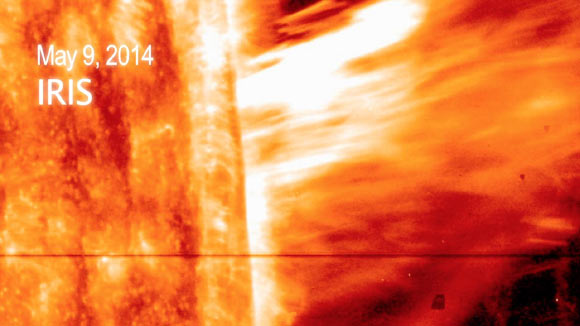Astronomers using NASA’s Interface Region Imaging Spectrograph have captured extraordinary footage of a colossal coronal mass ejection erupting from the Sun.

A colossal CME burst off the side of the Sun on May 9, 2014. Image credit: NASA’s Goddard Space Flight Center.
The Interface Region Imaging Spectrograph (IRIS) was launched in June 2013 to observe how solar material moves, gathers energy, and heats up as it travels through a little-understood region in the Sun’s lower atmosphere.
Tracking how material and energy move through this region is a crucial part of understanding the dynamics of the Sun. Such information can help explain what causes the ejection of solar material – from the steady stream of the solar wind to larger, explosive eruptions such as coronal mass ejections (CMEs).
CMEs, often called solar storms or space storms, are gigantic clouds of solar plasma drenched with magnetic field lines that are blown away from the Sun during solar flares and filament eruptions.
CMEs disrupt the flow of the solar wind and produce disturbances that strike the Earth with sometimes catastrophic results.
The first proof of CMEs came from observations made with a coronagraph on the OSO 7 spacecraft between 1971 and 1973.
IRIS must commit to pointing at certain areas of the Sun at least a day in advance, so catching a CME in the act involves some educated guesses and a little bit of luck.
A gigantic CME surged off the side of the Sun on May 9, 2014, and IRIS caught it in unprecedented detail.
“We focus in on active regions to try to see a flare or a CME. And then we wait and hope that we’ll catch something. This is the first clear CME for IRIS so the team is very excited,” said IRIS science team leader Bart De Pontieu from Lockheed Martin Solar & Astrophysics Laboratory in Palo Alto, California.
Watch the movie to see how a curtain of solar material erupts outward at speeds of 2.4 million km per hour.
The IRIS imagery focuses in on material of 30,000 kelvins at the base of the CME. The line moving across the middle of the movie is the entrance slit for IRIS’s spectrograph, an instrument that can split light into its many wavelengths – a technique that ultimately allows scientists to measure temperature, velocity and density of the solar material behind the slit.
The field of view seen here is about 5 Earth’s wide and about 7 and a half Earth’s tall.







